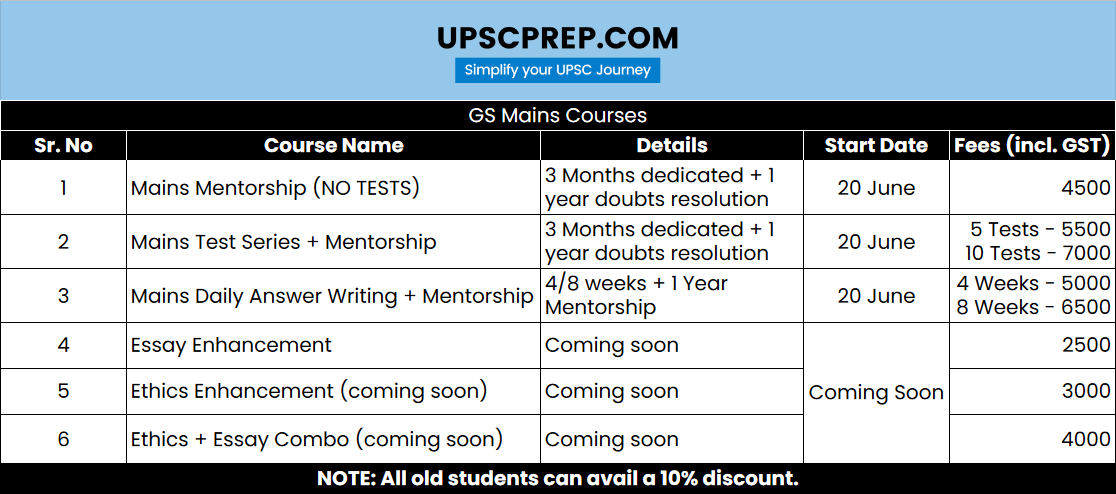Questions
Model Solutions
Want to get these answers evaluated?

Check out our new essay enhancement course
1. Enumerate the issues associated with functioning of the Central Information Commission. How can these issues be addressed? (10 marks)
2. Instruction in vernacular languages can boost inclusivity in higher education but it is not free from bottlenecks which need to be addressed. Examine. (15 marks)
Model Structure 1.
Introduction
● Central Information Commission (CIC) was established by the Central Government in 2005, under the provisions of the Right to Information Act (2005). ● It is a non-constitutional body.
Main Body
● Issues Associated with functioning of CIC-
○ Delays and Backlogs:
- On average, the CIC takes 388 days (more than one year) to dispose of an appeal/complaint from the date it was filed before the commission.
- 2.2 lakh+ RTI cases pending at the Central and State Information Commissions (ICs).
○ No Penalties:
- Government officials hardly face any punishment for violating the law. (Status report on Functioning of CICs)
- Penalties were imposed in only 2.2% of cases that were disposed of, despite previous analysis showing a rate of about 59% violations which should have triggered the process of penalty imposition
○ Vacancy:
- Despite repeated directions from the court, there are still three vacancies in the CIC.
○ Lack of Transparency:
- The criteria of selection, etc has not been placed on record.
○ Dilution of status and power of CICs
- By vesting powers to determine salaries and service conditions to the Central government Way Forward
● Underlying issues related to RTI Act should be resolved, so that it can serve the information needs of society.
● By its 2019 order, the apex court had passed a slew of directions to the Central and State governments to fill vacancies across Central and State Information Commissions in a transparent and timely manner.
● Urgent digitization of records and proper record management is important
● Section 4 of RTI (Proactive disclosure of information) should be used as a norm.
● The idea to give constitutional status to CICs needs to discussed Conclusion
● The right to question is the hallmark of a democracy. Any attack on the RTI law, which has empowered citizens to question those in power, is an attack on the foundation of our democratic republic.
Model Structure 2.
Introduction
● National Education Policy, 2020 (NEP, 2020) has emphasized the use of regional languages for instruction at the primary and higher education levels.
Main Body
● Positive Aspects of Higher Education in vernacular Language
○ Increase in Gross-Enrollment Ratio (GER): This will help provide quality teaching to more students - making higher education more inclusive
○ Better understanding of subject due to better comprehension in vernacular language
○ Higher Rates of Participation: Studying in the native language results in higher attendance, motivation and increased confidence for speaking up among students and improved parental involvement and support in studies due to familiarity with the mother tongue.
- Poor grasp of English has been tied by many educationists to dropout rates at the premier engineering education institutions as well as poor performance of some students.
○ Additional Benefits for the Less-Advantaged: This is especially relevant for students who are first-generation learners
○ Promotes Linguistic Diversity: It will also promote the strength, usage, and vibrancy of all Indian languages.
○ It would also help prevent language-based discrimination.
● Challenges
○ Availability of Quality Material in Regional Languages: Another challenge is the availability of study material such as textbooks and scholarly literature.
- Also, quality control of these translations will be of utmost importance to keep semantic irregularities at bay.
○ Availability of Faculty
○ Placement Associated Challenge: Many public sector units accept Graduate Aptitude Test in Engineering (GATE) scores for entry-level positions, which is conducted in English medium.
○ Given the already lamentable employability of college-educated individuals, studying in a regional language could further inhibit job opportunities
○ Insignificant for Institutions with Pan-India Admissions: A regional language focus is not meaningful in a scenario where the institutes see entrants from across the country such as IITs.
○ Delivering technical courses in regional languages may prevent students from competing in global labour and education markets, where fluency in English yields a distinct edge
● Way forward
○ Adopting the “Regional Language Plus English” Notion: While it is necessary to strengthen Indian languages as a medium of education, it is equally imperative for students to have a good command over the English language since they are global natives in the 21st century.
○ Bridging the Digital Divide: AICTE has recently developed a tool which translates English content online into 11 Indian regional languages.
○ While ensuring inclusion through the use of the mother tongue/ regional language, it should also set up a basic minimum standard of education which eliminates all disparity.
Conclusion
● A shift from “mother tongue versus English" towards the “mother tongue plus English" is required.
Previous Post
